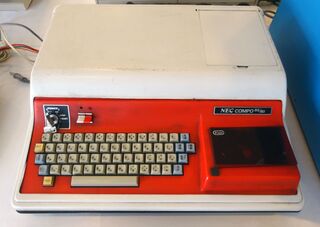Difference between revisions of "COMPO-BS/80"
From NEC Retro
| Line 17: | Line 17: | ||
{{sub-stub}}The '''COMPO-BS/80''' is a "personal computer" based on the [[TK-80BS]], manufactured to provide hobbyist with an out of box functioning BASIC machine. The release of the COMPO-BS/80 was followed by the release of the [[PC-8001]], NEC's first true personal computer. | {{sub-stub}}The '''COMPO-BS/80''' is a "personal computer" based on the [[TK-80BS]], manufactured to provide hobbyist with an out of box functioning BASIC machine. The release of the COMPO-BS/80 was followed by the release of the [[PC-8001]], NEC's first true personal computer. | ||
==Hardware== | ==Hardware== | ||
| − | The COMPO-BS/80 does not use a TK-80/E board, instead it uses a different dedicated CPU board for the [[μPD8080A]] chip | + | The COMPO-BS/80 is basically a TK-80BS with more RAM, a CPU and a case. It does not use a TK-80/E board, instead it uses a different dedicated CPU board for the [[μPD8080A]] chip which it attaches to the built in TK-80BS. |
| + | |||
| + | The COMPO-BS/80 was released in two versions: The COMPO-BS/80-A, which came with a built in cassette deck. And the COMPO-BS/80-B, which lacked said cassette deck, but could be used alongside an external one. | ||
The components of the COMPO-BS/80 were also sold individually, including the case, allowing owners of a TK-80/E to build their own COMPO-BS/80, this build doesn't allow for BASIC access from start-up, instead needing access to the TK-80/E's keypad for it. Alongside selling components, the COMPO-BS/80 had dedicated peripherals and expansion units that were marketed for it, and it was also compatible with older components such as the [[TK-M20K]]. | The components of the COMPO-BS/80 were also sold individually, including the case, allowing owners of a TK-80/E to build their own COMPO-BS/80, this build doesn't allow for BASIC access from start-up, instead needing access to the TK-80/E's keypad for it. Alongside selling components, the COMPO-BS/80 had dedicated peripherals and expansion units that were marketed for it, and it was also compatible with older components such as the [[TK-M20K]]. | ||
| Line 24: | Line 26: | ||
===Technical Specifications=== | ===Technical Specifications=== | ||
{{SystemSpecs | {{SystemSpecs | ||
| − | | ram= | + | | ram=7k |
| − | | rom= | + | | rom=8k |
}} | }} | ||
Revision as of 17:26, 8 October 2024

| |||||||||||||||
| COMPO-BS/80 | |||||||||||||||
|---|---|---|---|---|---|---|---|---|---|---|---|---|---|---|---|
| Manufacturer: NEC | |||||||||||||||
|
This teeny-tiny article needs some work. You can help us by expanding it.
The COMPO-BS/80 is a "personal computer" based on the TK-80BS, manufactured to provide hobbyist with an out of box functioning BASIC machine. The release of the COMPO-BS/80 was followed by the release of the PC-8001, NEC's first true personal computer.
Hardware
The COMPO-BS/80 is basically a TK-80BS with more RAM, a CPU and a case. It does not use a TK-80/E board, instead it uses a different dedicated CPU board for the μPD8080A chip which it attaches to the built in TK-80BS.
The COMPO-BS/80 was released in two versions: The COMPO-BS/80-A, which came with a built in cassette deck. And the COMPO-BS/80-B, which lacked said cassette deck, but could be used alongside an external one.
The components of the COMPO-BS/80 were also sold individually, including the case, allowing owners of a TK-80/E to build their own COMPO-BS/80, this build doesn't allow for BASIC access from start-up, instead needing access to the TK-80/E's keypad for it. Alongside selling components, the COMPO-BS/80 had dedicated peripherals and expansion units that were marketed for it, and it was also compatible with older components such as the TK-M20K.
Technical Specifications
- RAM: 7k
- ROM: 8k
- Floppy Disk drive(s): None
Promotional material
| μCOM Training Kit series hardware |
|---|
| TK-80 (1976) | TK-80E (1977) | COMPO-BS/80 (1979) | TK-85 (1980) |
| Components and Expansion Units |
| TK-M20K | TK-80BS (μCOM Keyboard) |
- ↑ 1.0 1.1 1.2 https://support.nec-lavie.jp/support/product/data/spec/cpu/b369-1.html (Wayback Machine: 2024-10-06 02:46)
- ↑ IO JP 1979-02.pdf, page 57